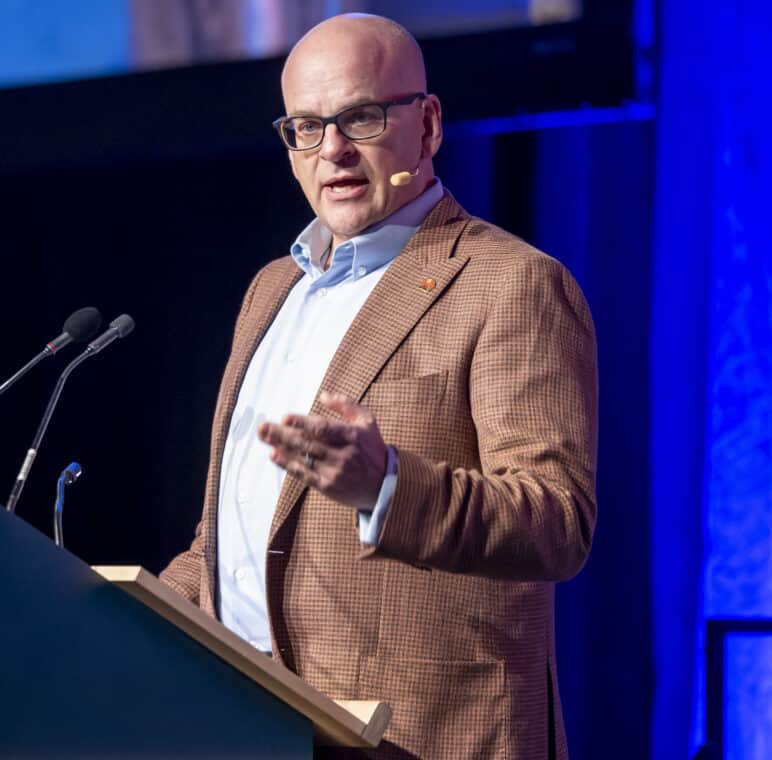We need to rethink how we support social transformation, says Centraide of Greater Montreal’s Claude Pinard. He offers five essential skills and pathways for catalytic philanthropy.
Philanthropy has worn many hats, evolving over the years along with society. Initially, philanthropy amounted to simple charitable actions: the giving of time, resources, or expertise to those who needed it. Eventually, it became more structured. Foundations, organizations, and programs were established to funnel efforts, maximize the impact, and invest more strategically.
In recent years, we’ve found inspiration in a number of promising movements. Trust-based philanthropy, for example, upturned the traditional donor–recipient relationship and the inevitable power imbalance this created.
Collaborative philanthropy based its approach on data and results. It also brought home the incredible expertise we’ve accumulated in the field, as well as the importance of diversifying our data collection to avoid blind spots caused by our biases.

But today, we need to recognize that these types of philanthropy have limits. The challenges we now face are as complex as they are systemic. Fighting poverty and social exclusion – the mission of Centraide of Greater Montreal, which I head – is a formidable challenge, and the underlying issues are numerous, interconnected, and deeply rooted in our societal structures. Take poverty. Poverty isn’t merely a matter of not having enough money; it’s linked to a plethora of factors such as health, education, discrimination, and access to opportunities.
The challenges we now face are as complex as they are systemic.
Sometimes we lose sight of what’s important in our search for a quick fix. We like to see change. We need our impact to be instantaneous. We want our donations to carry weight, to “pay off.” In philanthropy, concrete actions seem like a magic bullet. But it’s equally important to bring about long-term change and to pursue a far-reaching vision.
In praise of true collaboration
In our quest for a better world, we always circle back to this one question: “Are we truly making a difference?” There’s no straightforward answer. If we want to turn that answer into an unequivocal “yes,” we need to move beyond traditional approaches and transform the way we do things.
This is paramount. I believe that our current brand of collaboration is no longer enough. We need radical collaboration, a model that has given rise to great projects that continue to bear fruit. One of them is the Initiative montréalaise de soutien au développement social local and its neighbourhood round tables. The Collective Impact Project is another that brings together philanthropic, institutional, and community partners from different backgrounds under unified governance.
Still, I think that before we seek out collaborations or solutions to issues, we must first focus on developing a common vision of the issues themselves. For us to succeed in this, now more than ever, stakeholders need to increase their engagement. This is a role that philanthropy as a whole must both understand and embrace if we are to bring about a measurable, systems-wide impact.
We need to reassess our collaborative model and take it much, much further.
We need to consider a new, more community-based approach to philanthropy, one that supports action by, for, and with vulnerable groups. This means fostering a spirit of community where everyone has a voice and, above all, the means to realize their full potential. This movement has been growing since the pandemic, which seems to have awakened our sense of community and geared us to really work together.
We need to consider a new, more community-based approach to philanthropy, one that supports action by, for, and with vulnerable groups.
We need a collective approach that spans traditional boundaries of geography and areas of action, one that embraces a broader concept of community in which shared aspirations are the starting point for important conversations that yield common goals, the achievement of which we will assess together. In these frank but sometimes discordant conversations, power dynamics are tempered by the pooling of experiences. Everyone works for the common good.
The needs and challenges we face are particularly complex, and no foundation, individual, or agency holds the golden ticket to a solution. That’s precisely why we must set common goals. It doesn’t mean we have to check our egos or our allegiances at the door. We just have to realize that those common goals take precedence.
Similarly, it may seem complicated to bring together people from diverse bodies with equally diverse ambitions, but it helps build a healthier social contract. Take away that social contract and feelings of exclusion intensify and the sense of community withers. So common goals must prevail over individual or corporate interests in order to focus on the essential: achieving our targets. And, to be motivational, those targets must be measurable. It’s also essential that we establish evaluation and accountability processes that everyone can agree on.
We should never balk at having conversations with people outside our usual circle of stakeholders. Doing so forces us to confront how we do things and ask the questions that need asking. And maybe along the way, we find new methods for gauging our impact. Having tough conversations pushes us to stretch, change, and embrace different viewpoints, even if they are diametrically opposed to our own. We must agree to discuss social inequalities through the lens of social justice. Only true solidarity leads to real change. These discussions can be uncomfortable, but they are overdue.
Catalytic philanthropy
I believe our cause would benefit from a shift toward catalytic philanthropy. This approach has roots in both community philanthropy and radical collaboration. Catalytic philanthropy isn’t about Band-Aid solutions. It’s about digging deeper and making fundamental changes in the way systems work. Catalytic philanthropy champions cross-sectoral, cross-disciplinary, cross-generational, and cross-cultural collaboration. It’s about taking calculated risks and taking the long view.
Imagine a forest. If one tree gets sick, we can treat it individually. But if we discover that the disease has been caused by contaminated water, and that the water runs through the entire forest, treating a single tree won’t be enough. Catalytic philanthropy pushes us to look for the source of the contamination, understand the entire ecosystem, and target our actions accordingly.
Catalytic philanthropy encourages us to take a holistic view, collaborate with partners from different sectors, and take risks.
It encourages us to take a holistic view, collaborate with partners from different sectors, and take risks. Because change – profound, lasting change – often requires stepping out of our comfort zone, experimenting with new approaches, and even risking failure to find the path to success. We need to see the people we are trying to help as part of our team. We must incorporate their ideas and experiences.
The beauty of catalytic philanthropy lies in its ability to create an impact that resonates across generations. It doesn’t stop at giving people fish or teaching them how to fish. It seeks to understand why there are so few fish today and how we ensure that tomorrow, everyone can benefit from an ocean brimming with fish.
Truly supporting the development of catalytic philanthropy requires a profound realignment of our mindset, strategies, operations, and posture. Catalytic philanthropy rests on fundamental pillars, including five skills and five pathways that I consider essential (see below).
This level of collaboration, which focuses on transforming our systems, will force all of us to rethink the way we work and adopt a mediatory posture across the board. This, in turn, will spark and facilitate dialogue between partners, who will then be able to identify levers for change and mobilize resources strategically to achieve sustainable impact.
While radical collaboration focuses on the big picture, systemic mediation gets into the weeds in order to bridge disagreements, foster dialogue, and harmonize positions and perspectives.
That being said, this posture is not limited to resolving occasional conflicts or facilitating dialogue. The aim is to decipher the often cryptic language of systems, identify levers for action, and build bridges between stakeholders. While radical collaboration focuses on the big picture, systemic mediation gets into the weeds in order to bridge disagreements, foster dialogue, and harmonize positions and perspectives.
Imagine a group of hikers exploring mountainous terrain. They each have their own maps and compasses. They each use their skill sets and experience to choose which path to follow. They may come to a fork in the path and stop, unsure of the direction they should take. Systemic mediation is like having an elevated vantage point – a hill or boulder – that the hikers can climb to gain a better perspective and chart a way forward together. It doesn’t provide clear-cut solutions, but it does help to clarify your vision and steer you in the right direction.
In our interconnected world, where social and environmental issues are intertwined, actions in one area can have unintended repercussions in another. Systemic mediation provides tools to help us anticipate any domino effects, understand the underlying interrelationships, and act in an informed way.
But it goes beyond analysis and understanding. It’s also about instilling empathy into everything we do, lending a sympathetic ear, including to marginalized voices (whether within agencies or communities), and ensuring that our every act contributes to the collective good.
Many philanthropic actors already serve as ad hoc systemic mediators in their workplaces. What we need now is to formalize and legitimize this role. We need to hone our mediatory skills, define a systemic mediation code of ethics, and develop more formal mediation tools to maximize the systemic impact of our initiatives and achieve our objectives.
How can you become a facilitator, a mediator, a catalyst for change? Here are a few ideas that should give you food for thought. Think about how many collaborations you’re currently working on. Have you relinquished some of your power to the people around you? For example, do you involve external groups in your budget decisions?
It’s also important to show a little humility throughout the process because systemic mediation is not a magic bullet. It’s a tool that, when used wisely, can help us navigate a constantly changing world. It reminds us that our role as philanthropists is not to give blindly but to facilitate, connect, and, together, create.
A new call to action
To build a better future, we need to join forces, open our hearts, and never stop trying to seek common ground.
The most important chapters in history were not the work of isolated individuals but of communities determined to transcend the boundaries that divided them. Collaboration is not a choice; it’s a necessity. It is by working together, sharing resources, and embracing diversity that we can truly meet the challenges we face.
We have a responsibility – and an opportunity – to redefine philanthropy, together. This is my call to action, an open invitation to collaborate and innovate. It’s equally a plea to see that the complex social issues we face are bigger than us and our organizations.
Catalytic philanthropy drives positive change in a strategic and transformative way. Each·of us has the power to be a catalyst for good, to sow the seeds of progress and inspire others to follow our example.
Collaborating is sometimes – nearly always, I might even say – frustrating! And yet – to come back to the image of our hiking group – when we succeed in rising above our own self-interest and harnessing our talents so a maximum number of people can benefit, not only do we contribute to a better society, but we all emerge stronger and more resilient.
Systemic mediation can therefore be seen as the ties that bind the threads of our social fabric. By building mutual understanding, listening with empathy, and seeking inclusive solutions, we can resolve conflicts, heal wounds, and build bridges where there was only division. It is a long, hard journey that requires courage, perseverance, and unwavering faith in our collective capacity to forge a peaceful, prosperous future.
Let us all be a catalyst for positive change. Let’s commit to being mediators who bridge the differences between us. Together, we can work miracles, overcome obstacles, and write a story that will resonate across generations.
The future of philanthropy calls for more complex but also more rewarding roles. I am convinced that we are ready·to meet this challenge.
Five essential skills for catalytic philanthropy
1. Systems thinking
Understand and analyze complex systems, recognize interconnections, and identify levers for change.
2. Adaptability
In the face of constantly evolving systems, remain flexible and able to readjust strategies according to changing circumstances.
3. Strategic communication
Convey complex messages to diverse audiences and engage in constructive dialogue.
4. Long-term vision
Focus on sustainable impacts rather than on short-term solutions. Maintain a two-pronged approach: be responsive to immediate needs while being able to see things from different angles and plan for sustainable solutions.
5. Transformative leadership
Inspire and mobilize around a common systemic vision while fostering the autonomy and capacity of partners, organizations, and communities to act.
Five pathways to catalytic philanthropy
1. Decentralized decision-making
Transfer some decision-making powers directly to communities and let them decide how to use the funds, which projects to undertake, and which leaders to support.
2. Data analytics
Collect, analyze, and interpret data to measure the systemic impact of our actions and inform future decisions. Anticipate and track certain social changes within a specific territory (e.g., identify and monitor weak signals such as changes in the narrative).
3. Sustainable funding models
Instead of one-off project-based funding, support agents of change that have a potential systemic impact with significant stable long-term funding. This allows them to concentrate on creating change without the headache of financial considerations.
4. Social research funding
Support research, experimentation, and development of new systemic approaches to address social and environmental issues. Allow the agencies to get off the beaten track and explore new possibilities. As Albert Einstein is quoted as having said, “We cannot solve our problems with the same thinking we used when we created them.”
5. Radical collaboration
Only fund organizations that collaborate with a diversity of stakeholders or participate in collaborations that invite “unusual suspects” to come to the table and promote a diversity of experiences. Help break down silos by making radical collaboration a non-negotiable requirement.
This piece was written in collaboration with Patrick Dubé, co-founder of the Transition Bridges Project.


